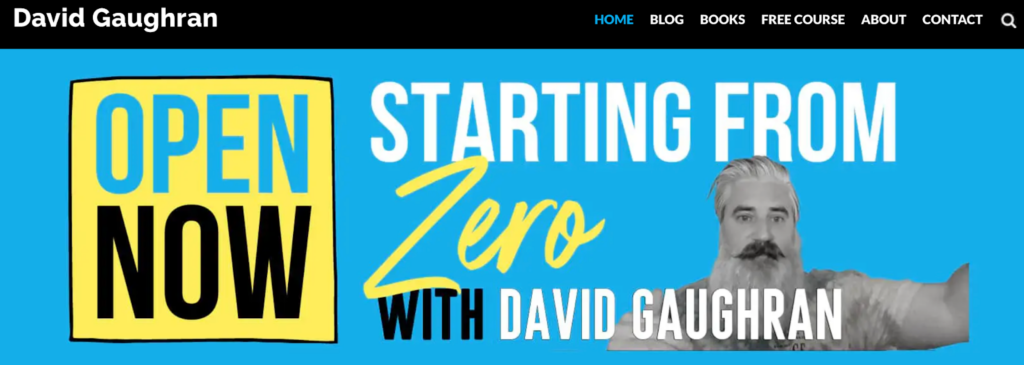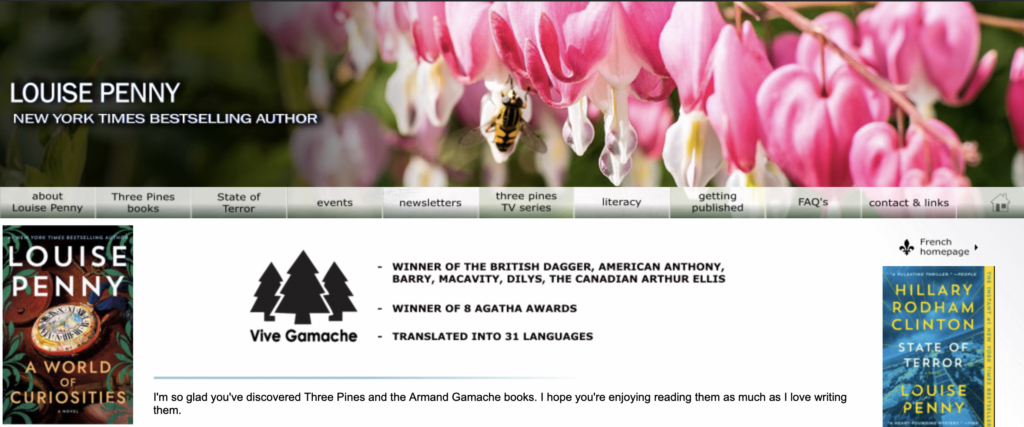Imagine having thousands of potential readers actively searching keywords relating to your book, passively going through your book marketing funnel, resulting in a sale.
Sounds like a dream scenario right?
Well it’s completely real with search engine optimization (SEO) as a marketing channel.
There is so much involved with search engine marketing that it causes authors to ignore it completely.
For authors that are in it for the long term, and want to start crushing it with SEO now, Booklinker created the ultimate guide to SEO for authors.
In order to create such an important article, we spoke with Harry Bingham of JerichoWriters and author of the Fiona Griffiths Crime Series.
Without further ado, let’s get right into our guide on author SEO.
Table of Contents
Free Universal Book Links
- Boost international sales by geotargeting readers
- Book store links update automatically based on availability
- Advanced marketing analytics
- Increase clicks with trusted links
What is SEO?
SEO stands for search engine optimization, and describes the art of studying how search engines work in order to drive more traffic to your website content.
While we mention “search engines”, there’s really only one that matters, and that is Google, with over a 93% market share as of March 2023.
Due to this, we’ll be referencing the Google algorithm in this post, but many tactics should hold true for Bing, DuckDuckGo, and others.
When Should an Author Start Looking at SEO?
Authors should start looking at SEO as a book marketing channel pretty much as soon as they decide they want to commit to authorship long term.
SEO is a very powerful strategy, and likely to be the highest return on investment strategy that you have.
Speaking for JerichoWriters, we use SEO to attract creative writers from across the world to our website, then do what we can to gather the email addresses of those writers.
These two engines combined – SEO and our mailing list – are way the most important element of our marketing success, accounting for much more than 50% of all sales.
If you’re an author, the model will work a little differently. You’ll make your sales from Amazon (and Apple and Kobo and so on), but you can build an audience and collect email addresses via your website.
So the more traffic you build, the stronger your marketing tools become.
But it’s not fast, and takes a lot of time to build.
For example, if you know you’re going to be publishing a book on the American Civil War in a year or two’s time, you should start to build your blog type content now.
This way, you give Google time to start to understand who you are and what type of content you put out.
By the time you have a book out on the shelves, and you play your SEO cards right, you’ll get readership and a position in Google.
Introducing:
Booklinker Collections
One landing page for all your books. 100% free.
One link for easy sharing of your books across your backmatter, websites, emails, and social media.
What Type of Authors is SEO For?
Here’s the deal: Novelists aren’t going to get a lot out of author SEO.
The reason for that is perfectly simple. If your book is the best thriller writer in the world, you could rank for the keyword “great thrillers.”
But realistically, readers don’t typically go to Google and search for the next novel.
They’re going to use Amazon search to find the next novel that they’re going to read. (Although we’ll come across an important caveat to that later.)
On the other hand, non-fiction is a different story.
If you have an amazing blog on the history of the American Civil War, readers will come to that blog for the content and if promoted correctly, notice that you’ve got a book on that topic.
How Can Authors Utilize SEO?
Authors can utilize SEO as a passive, evergreen, book marketing strategy.
By putting up content that ranks for target keywords, authors can get themselves and their books in front of their ideal audience.
With nonfiction, it’s very common for authors to have other products to sell beyond a book.
Examples of upsells include online courses, workshops, seminars, and speaking opportunities.
The book is, in effect, the low-cost portal into some more expensive services. But for all of those things, nonfiction is very well tailored to SEO.
How to Start SEO
After deciding that SEO is the right fit for your book marketing strategy, the first step would be to get your author website online, assuming it’s not already.
Without an author website, you’ll have nowhere to write your content.
You could use a service like Substack or Medium, but it’s not recommended as they’re not hosted at a domain or platform you control and own.
WordPress makes a great choice for 99% percent of authors.
Check out this guide on how to set up a WordPress website from start to finish. AuthorBytes is a popular done for you service in the author community for setting up websites for authors.
Picking a Domain Name
When it comes to picking a domain name to host your website and blog, you want it to just be your author name, and ideally a .com.
Best practice would be Harrybingham.com, and NOT harrybingham.wordpress.org.
On that same note, let’s say your name is George Bush, there are probably some better known George Bush’s out there. So in that case, you’d want to do a domain name like georgebushauthor.com.
Don’t use the book title as your domain name as you’re likely going to write more books, and readers won’t necessarily know what your first book is called.
To recap, go with your (first name)(last name).com or (first name)(last name)author.com.
Some variant of that is how you want to title your website.
You can buy your domain name at any domain name registrar with Namecheap and GoDaddy make great options.
Setting up a Blog
Once your author website is online it’s time to set up a blog section.
A blog is a place where you can put out written content in an organized manner and share it easily.
WordPress comes with a ton of themes, plugins, and integrations making it easy for authors to get started here.
When doing SEO, there are two different parties you want to take into account. Both are equally important, and they are the reader, and Google’s robots.
As you start expanding your library of material, Google is going to start crawling your website more and more. This process allows Google to better understand not only what each page is about, but also their relationship to each other.
Keyword Research
In order to rank for your target keywords, you first need to create the content that Google would want to rank. Google wants to rank content that’s best for their users’ search journey.
In Google’s eyes, the worst thing that can happen is for a searcher to input a query, click on a result, not find what they’re looking for, repeat the process over again, and then X out.
To prevent this, they monitor the user experience and behaviors upon landing on a page, to decide what to rank.
While there’s plenty of advanced tools you could use to check what Google wants to rank for a query, the easiest (and free!) method is to Google the keyword yourself and see what’s there already.
For the above American Civil War example, it’s pretty clear a blog post about funny cat videos is not going to show for that keyword. A long form piece of content describing the history of the war will stand a better chance.
Take note at the authority level of the sites ranking in the first two positions, Wikipedia and Encyclopedia Britannica.
It’s going to be near impossible for an author to rank for a keyword like this. This introduces us to the concept of domain authority which we’ll cover later.
For newer authors who have a less authoritative site, you’re going to need to chase relatively long tail keywords.
Long tail keywords are generally longer (more words), specific search keywords that have fewer monthly searches, BUT are much less difficult to rank for.
“American Civil War” is a short tail keyword with a vast number of searches on it over the course of a month.
An example of a long-tail keyword would be: “Who won the Battle of Gettysburg.”
You could go even more specific to: “Battle of Gettysburg strategies.”
Newer sites should address relatively more niche topics until they’ve got the authority to build towards higher volume topics.
We’ll cover how to build authority in a later section.
By now you should see the power of keyword research, but it may not be exactly clear how to do it.
How to Start Keyword Research
The first step we’d recommend is to first research and understand your target reader. If you’re writing a book about a topic, you likely already have a pretty good head start here.
The second step in the keyword research process is to map out the topic, identifying all of the subtopics that fall under it.
Think about what keywords your reader would be interested in that also overlap with your content.
Remember, our goal is to convert this passive traffic into emails captures and book sales.
Keyword research tools we standby include:
- Ubersuggest (Free)
- WordStream (Free)
- Ahrefs (Paid)
- SEMRush (Paid)
Google also has a keyword research tool under their ad planner that you could use as well.
For most authors, until you’ve got really meaningful traffic, and monetized their website significantly, you shouldn’t pay for the paid tools, as powerful as they are.
At the end of the day, all of these companies get their keyword data from Google itself.
For newer authors and websites, you’re looking for keywords that have volumes under 1000 searches per month.
These may not seem like a lot, but these keywords have multiple variants.
- “Tactics at the Battle of Gettysburg”
- “Battle of Gettysburg Tactics”
- “What Were the Tactics at the Battle of Gettysburg”
- “Gettysburg Tactics”
Google will understand all of those kinds of topics are broadly similar. So you don’t need to optimize for each. The total search volumes are going to be much greater than Google is suggesting.
If you take a look at the first page of Google for your target keywords, and there are one or two other niche bloggers like yourself in the search results, that’s Google telling you that yes, you do have the potential to rank.
Ultimately, when it comes down to keyword research you need to use your common sense. All the tools in the world will be useless without your own judgment.
SEO Tactics
Next, we’ll break down some big picture SEO terms and tactics. We’ll split this into three main sections of On-Page SEO, Off-Page SEO, and Technical SEO.
On-Page SEO
On page SEO refers to how you optimize your own content for discovery on search engines.
Components of On-Page SEO include:
- Page Title & Header Tags
- URL
- Links (Internal and External)
- Images
- Keyword Density
Page Titles and Header Tags
The first on-page SEO element we’ll cover is the header tag. Header tags are a search engine indexable HTML tag that organizes your page in terms of hierarchy.
The page title is going to be a Header 1 (H1) in most cases, followed by Header 2s (H2s) for main topics. If you need to break a topic down even further you can use H3s and H4s, but it’s not worth going past that.
Be sure to include your target keywords and tangential keywords inside of your headers, ideally towards the left hand side.
Examples of some H2s and H3s could be:
- Tactics at the Battle of Gettysburg
- Strategy at the Battle of Gettysburg
- Timeline of the Battle of Gettysburg
Header Tags are one of the most important SEO signals to Google so be sure to spend a lot of time outlining your articles headers before writing the post.
URLs
Another on-page signal that’s super important to Google is the page’s URL structure. This is the web address that a page is hosted on and comes after the domain name.
Back to our civil war example, it would be something like:
- (website domain).com/american-civil-war/
Best practice for URL structure is to include your target keyword inside of it in a way that’s easily readable for both humans and search engine robots.
We could take it a step further, delving into our sub topic by making another URL:
- (website domain).com/american-civil-war/battle-of-gettysburg/
Inside of your URLs, avoid including unnecessary characters, dates, or filler words. Keep them short and sweet, and to the point.
From Google’s perspective, if the URL matches the header tags, they’ll have an extra degree of confidence that your page is about a given topic.
Keyword Density
Keyword density is the idea that in order to persuade Google that your page really is relevant to a particular topic, you need to mention your keyword a certain percent or number of times in an article.
This may have worked several years ago, but it’s certainly old fashioned thinking these days.
Google assumes that your content is natural, authentic, written by experts, so it wants you to write naturally in a way that confirms to Google your page is relevant to this topic. If anything, keyword stuffing is going to harm you more than help.
Just make sure that you’re naturally using your list of your primary keywords, and sensible secondary keywords, and you’ll be ok here.
Images
Images are mostly there to break up the text and make the article more visually attractive.
Images also have alternate text on them, where you can put keywords, it’s not a major ranking factor, but certainly worth including.
It also ensures a pleasant reading experience for any blind or vision impaired people.
Any images included inside your blog posts should be copyright free or credited to the original photographer.
Stock images can work, but the best content will be made from custom graphic and original images.
Internal and External Links
Links are a huge deal in SEO. The success of Google as a company was based on the insight that when website A links to website B, it’s effectively a vote of confidence by Site A to Site B that it’s a good resource.
Google will reward sites for helping in this system when they externally link to other useful resources inside of their articles.
You don’t want to forget about internal links either, because your own site has its own authority.
Let’s say you have 30 blog posts written, the only way to get to older ones would be by navigating backwards an older posts tab. Users would have to keep navigating back until eventually they made it to the first blog. You want to avoid that poor user experience.
Internal links solve this, by connecting a websites pages together. Make sure that you interlinked your blog’s very well, with descriptive anchor text, to the point where a reader should only ever be about two or three clicks away from every other article on your site.
Table of Contents
Table of contents are definitely worth including inside of your article as they help both parties navigate the content.
In the case of Google, they clearly outline the hierarchy of your blog post for their robots to understand.
For the end user, they provide an overview of the articles layout as well as providing jump links allowing them to skip to a desired section of an article.
Another bonus of including a table of contents is that Google will reward you more search engine result page real estate if they detect one.
SSL Certification
Most sites are going to have an SSL certification these days, but you just need to make sure that your site is properly secure. Meaning you’re going to have an HTTPS tag at the top of your URL instead of just the old fashioned HTTP.
Off-Page
Next, we’ll cover off-page SEO, which describes SEO signals that are not directly related to the content of a given page.
Social Mentions
Social mentions are another off page metric that refers to your content being shared, promoted, and engaged with on social networks.
While it’s somewhat debated in the SEO community on if it actually is a Google ranking signal, and to what extent, it’s worth covering here.
It’s best practice to share any articles you publish on social media networks, ideally ones where you have a following, in order to generate more views and backlinks.
Social engagement is one of the best indicators that you’ve made a solid piece of content.
What you will find is that social media can give you a quick traffic kick, but it’ll fall off quickly, and eventually drop to zero.
SEO works the other way, where you’ll get absolutely nothing on day one, but as Google crawls the post more and more, over time, and as the authority of your site grows over time, you’ll get more and more traffic to that post.
So social media is a great way of getting eyeballs and potentially links straightaway on your content. It can also help improve the organic rankings of your blog posts assuming they are well engaged.
Domain Authority & Backlinks
Domain authority not a term that Google ever uses, but speak with any SEO and you’ll hear it brought up. It refers to how authoritative a given website is in the eyes of Google.
We touched on links and authoritativeness earlier, but it’s derived from the number and quality of external links pointing towards a website.
A mention from the New York Times is going to mean a lot more to Google than one from mynicheauthorsite.com.
The more links that site B accumulates around the web, the more votes of confidence it gets. If Site A is high authority, then links from it are going to count more than links from a site that has few links and low traffic.
To accumulate those links, you need to reach out to fellow bloggers, fellow historians (in our example), fellow writers in your niche and build relationships to persuade others that your material is worth linking to.
By creating best in class content you can also receive backlinks passively and naturally.
SEO Titles
Next, let’s talk about SEO titles and meta descriptions.
These might sound intimidating, but they are something you’ve likely seen thousands of times over when Googling anything.
The main goal here is to include your target keyword(s) and going for a high click through rate on the search engine result page.
You need to make sure that your page title includes the keywords on the left of the page title.
So if your page is on the Battle of Gettysburg, it could be something like:
Battle of Gettysburg: Tactics, Strategies, Timeline, & More
Notice how we put the actual keyword “Battle of Gettysburg” on the left hand side. The other keywords are there to signal to your ideal reader that this is a page they should click on, because you’re going to cover everything they want to know about.
But it’s also you’re going to bring in some kind of long tail keywords like “Tactics of the Battle of Gettysburg.”
Technical SEO
Sitemap Files
Technical SEO is a pretty deep rabbit hole that is probably not worth spending a ton of time on, but there’s a few things you’ll want to make sure are done correctly to make your website as easy to crawl as possible.
Google asks that webmasters submit a sitemap in the form of an .XML file in order for it to better understand the structure and layout of the website.
There are several services and WordPress plugins such as Yoast and RankMath that will do this for you.
Once a sitemap is generated, you’ll want to submit it to Google through Google Search Console.
Core Web Vitals & Mobile Experience
Core Web Vitals is a newer test that Google is rolling out for webmasters that tracks the user experience and loading speed of your website. You can run your website through their test here.
Inside Google Search Console you can view Google’s scores for both of these tests to see if your site is passing. If you decide to go with WordPress, consider a plugin like WordPress Rocket to help get your website passing Web Vitals.
Removing 404s
An essential part of technical SEO is ensuring that your website doesn’t have any HTTP errors, for example, a 404 error.
A 404 error occurs when a web server is found, but a desired page hosted at a web address was not.
This can create a poor user experience, when a reader clicks somewhere and gets taken to a page that doesn’t exist. Google will reward sites that stay on top of their HTTP status code errors.
Examples of Authors Doing SEO Well
Now that you have a background on how SEO works and what elements matter to Google, let’s take a look at a few authors that are doing SEO well, and break down what they’re doing and why it’s working.
David Gaughran
The first example we’ll take a look at is David Gaughran, an author with a blog on a variety of book marketing content on it. He ranks for keywords such as “book promotions” and “book advertising.” Considering his books are about book marketing, it’s the perfect audience to present them in front of.
Ben Goldacre
Ben Goldacre’s blog was so successful, it didn’t just get him multiple book deals; he did all the most important marketing for those book deals by just contacting his mailing list.
The search traffic stats are misleading: the referral traffic and direct traffic are off the charts. He knows how to find his audience, then he knows how to keep them
Louise Penny
Now this is an interesting one – Penny has huge traffic stats, but that traffic mostly relates to people looking for her or her books. Since those users are mostly going to be buying from Amazon, you could argue that Penny is “wasting” her traffic by bringing it to her site instead of Amazon.
But that’s not the way to look at it.
Amazon is full of authors who compete with Louise Penny.
So by bringing the traffic direct to her website, Penny can:
- Offer a much more curated, creative and personal view of her world
- Present and define herself and her books exactly as she wants
- Collect email addresses,
- Offer other merchandise
- attract readers to mini writing courses, physical or online events, or whatever else Penny might have to offer.
The richness of that personal website experience is profound. And yes: you’re not taking users from “cold” to “hot”, you’re taking readers who are already engaged and just deepening that connection. But that’s a profoundly important journey.
They say that if you have 1,000 really committed ambassadors for your product, then your product will be a hit. And there’s real truth there. Amazon is functional and effective, but it’s not heart-warming.
By grabbing the traffic yourself, you won’t lose sales – and you will gain hearts.
Conclusion
SEO is an extremely important component of a nonfiction authors book marketing strategy, and makes sense for all serious authors to start working on.
There are thousands of keywords you can put up relevant content for, bringing your ideal audience straight to your website.
In order to start SEO, you need to have an author website online, and a blog for you to start posting longform content.
Once this is in place, start doing keyword research using the free and/or paid tools we mentioned above to find ideas for articles.
After writing and publishing some articles, make sure to pay attention to the on-page SEO metrics we covered such as property header tags, internal and external linking, contextual value add images, and a table of contents.
On-page SEO is arguably the most important factor, but if you notice traffic plateauing then it can be worth spending significant time on off-page factors such as link building and CTR optimized SEO titles and meta descriptions.
Lastly, make sure your site’s architecture is in place correctly by following the technical SEO tips we shared.
This includes making sure your website is fast, passing Google Core Web Vitals, making sure you have a sitemap submitted, and little to none 404 errors.
Follow this advice, and I have no doubts you will start bringing in passive traffic to your blog in no time.
If you have any questions about author SEO, be sure to drop me or the Booklinker team a comment below, and we’ll get back to you promptly.
Introducing:
Booklinker Collections
One landing page for all your books. 100% free.
One link for easy sharing of your books across your backmatter, websites, emails, and social media.
Author
-
Harry has written a variety of books over the years, notching up multiple six-figure deals and relationships with each of the world’s three largest trade publishers. His work has been critically acclaimed across the globe, has been adapted for TV, and is currently the subject of a major new screen deal. He’s also written non-fiction, short stories, and has worked as ghost/editor on a number of exciting projects. Harry also self-publishes some of his work, and loves doing so. His Fiona Griffiths series in particular has done really well in the US, where it’s been self-published since 2015.



















